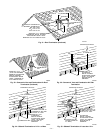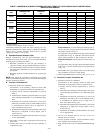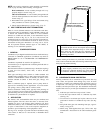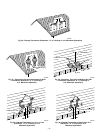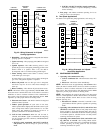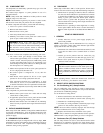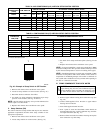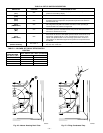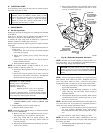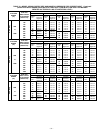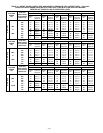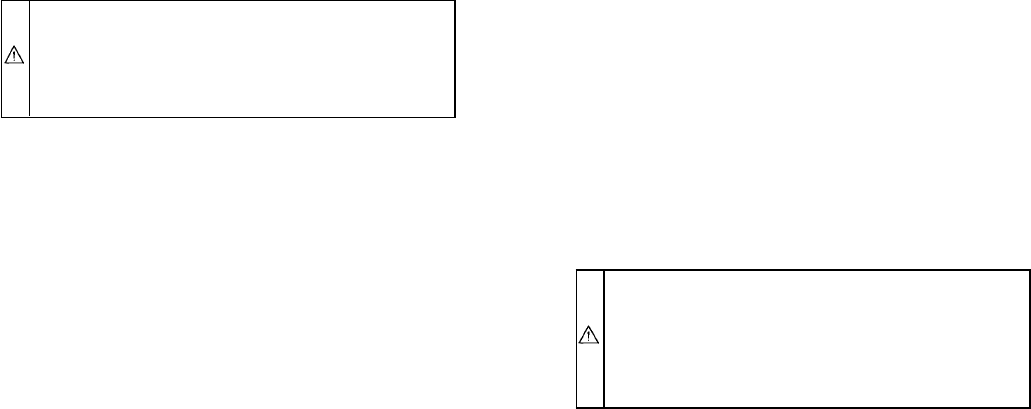
VIII. COMPONENT TEST
All components are functionally operated except gas valve with
component test feature.
This feature helps diagnose a system problem in case of a
component failure.
NOTE: Setup switch SW-1 MUST be in OFF position or Fault
Code 22 (setup error) will occur.
NOTE: NO thermostat signal may be present at control center,
and all blower time delay off periods must be completed.
To initiate component test feature, proceed with the following:
1. Leave 115-v power to furnace turned on.
2. Remove main furnace door.
3. Remove blower access panel.
4. Turn setup switch SW-6 to ON position.
5. Manually close blower access panel door switch. Use a
piece of tape to hold switch closed.
WARNING: Blower access panel door switch opens
115-v power to control center. No component operation
can occur. Caution must be taken when manually closing
this switch for service purposes. Failure to follow this
warning could result in personal injury or death.
When items 1-5 have been completed, the following will occur:
1. The control center goes through a brief self-test. This
self-test takes approximately 2 sec to complete. After door
switch is closed, red (microprocessor) LED briefly comes
on. Then green LED comes on for 1 sec, followed by 1 sec
where both green and yellow LEDs are on. During this time,
the microprocessor is checking itself.
2. Inducer motor operates for 20 sec at low speed, operates for
20 sec at high speed, then turns off.
3. Hot surface ignitor is energized for 15 sec, then de-
energized.
4. Main blower motor operates for 20 sec at low speed,
operates for 20 sec at high speed, then turns off.
5. After component operation test is completed, 1 or more
fault codes (11, 22, 41, or 42) will flash. See service label
on back of main furnace door for explanation of fault codes.
NOTE: To repeat component test, turn setup switch SW-6 to OFF
and then back to ON.
After component test, perform the following:
1. Release blower panel access door switch and turn setup
switch SW-6 to OFF position.
2. If applicable, replace blower access panel and check LED
status by removing plug in blower access panel.
3. Reinstall main furnace door if all LEDs are off, indicating
furnace is ready to operate when a signal from thermostat is
received.
IX. BYPASS HUMIDIFIER MODE
When setup switch SW-3 BPH is in ON position, RPM calculated
for low heat is multiplied by 1.15 for all furnace model sizes. This
compensates for increased return-air temperature caused by by-
passed air supply.
X. DEHUMIDIFICATION MODE
If dehumidification input is energized with a 24-vac input, RPM
calculated for cooling and continuous fan is multiplied by 0.85 for
all furnace model sizes. This compensates for high humidity
conditions during cooling operation.
XI. ZONE MODE
When setup switch SW-5 MZ is in ON position, blower motor
control is the same as above except with the following exceptions:
1. While blower is operating in either low heat or continuous
fan, the coast down calibration is performed once a minute
to update blower RPM for zone damper position changes
during a given cycle unless the blower pulse width to
blower motor is greater than 60 percent. This prevents
nuisance faults from occurring when a high continuous fan
CFM has been selected.
2. While blower is operating in either high heat or cooling,
blower pulse width to blower motor is frozen when blower
RPM is within 10 percent of calculated blower RPM for 5
sec.
START-UP PROCEDURES
I. GENERAL
1. Furnace must have a 115-v power supply properly con-
nected and grounded.
NOTE: Proper polarity must be maintained for 115-v wiring. If
polarity is incorrect, control center fault indicator light flashes
rapidly and furnace does not operate.
2. Thermostat wire connections at terminals R, W/W1, G, and
Y/Y2 must be made at 24-v terminal block on control
center.
3. Natural gas service pressure must not exceed 0.5 psig
(14-in. wc), but must be no less than 0.16 psig (4.5-in. wc).
4. Blower access panel must be in place to complete 24-v
electrical circuit to furnace.
CAUTION: These furnaces are equipped with a manual
reset limit switch in burner box. This switch opens if an
overheat condition (rollout) occurs in burner enclosure.
Correct inadequate combustion-air supply or improper
venting condition and reset switch. DO NOT jumper this
switch.
Before operating furnace, check each manual reset switch for
continuity. If necessary, press button to reset switch.
II. SELECT SETUP SWITCH POSITIONS
A. Air Conditioning (A/C) Setup Switches
The air conditioning setup switches are used to match furnace
airflow to cooling unit used. This furnace will provide 400 CFM
per selected air conditioning tonnage.
To set the desired cooling airflow:
1. Remove main furnace door and blower access panel.
2. Locate A/C setup switches on control center. (See Fig. 25.)
3. Determine air conditioning tonnage used.
4. Use Table 8 or wiring schematic to determine proper setup
position of A/C switches. (See Fig. 24 and 45.)
NOTE: Excessive airflow caused by improper A/C switch setup
may cause condensate blow off in cooling mode.
5. Replace main furnace door and blower access panel.
NOTE: EAC-1 terminal is energized whenever blower operates.
HUM terminal is only energized when gas valve is energized.
B. Continuous Fan (CF) Setup Switches
The CF setup switches are used to select desired airflow when
thermostat is in continuous fan mode. This setup feature allows
continuous fan airflow to be adjusted. To set desired continuous
fan airflow:
—34—




